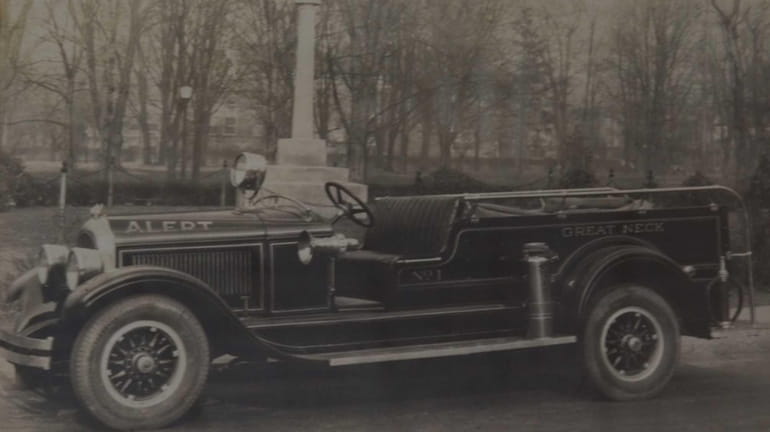Great Neck firehouse's history preserved

Walter P. Chrysler donated this fire truck to the Great Neck Alert Fire Company in 1927. Credit: Handout
It took Tom Jennings three years to join Great Neck’s Alert Fire Company No. 1 -- not because he wasn’t capable, but because he was on a waiting list.
He joined the company 49 years ago at age 31. He now spends his time not only on call to respond to fires, but also collecting firefighter memorabilia and history to honor the departed.
He began a historical committee 20 years ago, which now has 14 members. The firehouse’s second floor is a meeting space filled with glass cases with memorabilia, sculptures, awards and photos.
“We all love this fire company and we all try to do good by it,” said Jennings, who has lived in Great Neck for 52 years. “Every day, you get out there to save someone or a house is a good day.”
The company formed in 1901, with only a hose reel and pumper. Millionaire automaker Walter P. Chrysler of Kings Point became one of the first honorary members of the company, donating a fire truck.
Jennings said that in the early 1900s -- because the community and the station’s members were wealthy -- they purchased a horse-drawn, steam-powered engine to put out fires.
“If you were the first to come to the firehouse and you came with a horse, you’d get 50 cents a horse,” Jennings said. “That was a lot of money back then.”
Firefighting technology improved, but challenges remained. Jennings remembers responding to a fire in the late 1960s at what was then called Gristedes supermarket on Middle Neck Road -- where an Everfresh market stands today.
“The gas main ruptured and set the store on fire on a Saturday at 2 in the morning,” he said. “It was zero degrees out, and we had a hard time because the temperature was so low and the water mains were frozen. It burnt to the ground.”
When the sirens would echo through his neighborhood, George Motchkavitz remembers riding to the station with a blue light on his bike, asking where the fire was. He and his group of friends would then ride to the fire and watch. He joined the fire department in 1972. Now 56, he’s an assistant foreman at the station.
Motchkavitz helped form the Great Neck Junior Firefighters in 1982.
“We had 16 juniors the first year, and now we have 30,” he said. “They get a dress uniform and go on parades, learn to use hoses and climb ropes. We don’t put them in live fires, but they crawl on the floor through thick smoke to find dummies at a training house near the annex firehouse on Steamboat Road in Kings Point.”
In 1992, Robert Levine, a 15-year-old student at Great Neck North High School, fell 60 feet into a well on Stuart Street, shattering his heel, hitting his head and severely injuring his back.
“When I got there in my street clothes, I put the harness on, grabbed a flashlight and radio and fastened the rope,” he said. “In 58 minutes, they pulled us out of the hole, and the kid wouldn’t let go of my hand. Later on, when I visited him at the hospital, his father came up to me and asked if I’d do it again and I responded, ‘In a heartbeat.’ ”
The satisfaction of saving someone’s life and responding to a multitude of fires over the years makes him proud to be a part of the fire company.
“If it wasn’t for firefighters being crazy and doing it all for free and on their own time, do you know how many people would have died over the 100 years that this company has been around?” he said. “This is just what you do for your community.”
Above: Walter P. Chrysler donated this fire truck to the Great Neck Alert Fire Company in 1927. (Aug. 30, 2012)
Updated 7 minutes ago Gilgo-related search in Suffolk woods ... Urologist trial update ... Construction work zone safety ... Jericho fatal crash
Updated 7 minutes ago Gilgo-related search in Suffolk woods ... Urologist trial update ... Construction work zone safety ... Jericho fatal crash
